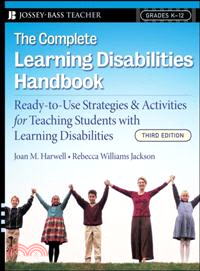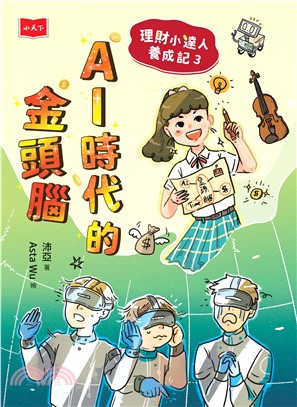The Complete Learning Disabilities Handbook: Ready-To-Use Strategies & Activities For Teaching Students With Learning Disabilities, 3Rd Edition
商品資訊
ISBN13:9780787997557
出版社:John Wiley & Sons Inc
作者:Harwell
出版日:2008/09/22
裝訂/頁數:平裝/416頁
規格:27.9cm*21.6cm*3.8cm (高/寬/厚)
版次:3
商品簡介
作者簡介
目次
相關商品
商品簡介
The third edition of this classic resource is a comprehensive source of information, strategies, and activities for working with learning disabled students. The book offers special educators, classroom teachers, and parents a wealth of new and proven suggestions and ready-to-use materials for helping LD students of all ages learn and perform at their fullest potential.
作者簡介
Joan M. Harwell has more than thirty years' experience as a classroom teacher and special educator. Harwell is the best-selling author of numerous books in the special education field.
Rebecca Williams Jackson has more than twelve years of experience working with students with learning disabilities. She works as an educational consultant and advocate for students with learning disabilities and their families.
Rebecca Williams Jackson has more than twelve years of experience working with students with learning disabilities. She works as an educational consultant and advocate for students with learning disabilities and their families.
目次
Acknowledgments.
About the Authors.
About This Book.
1 An Overview of the Field of Learning Disabilities.
History of Learning Disabilities.
Causal Factors.
Incidence.
Primary Characteristics of Learning Disabilities.
Comorbid or Co-occurring Conditions.
Attention Defi cit Hyperactivity Disorder.
Conduct Disorder.
Tourette Syndrome.
Prognosis.
Programs and Settings for the Learning Disabled.
Facts About Learning Disabilities.
List of Major Organizations for the Learning Disabled.
Periodicals on Learning Disabilities.
2 Research in the Field of Learning Disabilities.
Overview of the Brain, Biology, and Behavior.
Brain Injury.
Structural Brain Differences.
Biochemical Infl uences.
Research on Memory.
Research on Metacognition.
Research on Phonological Processing Problems.
Research on Maturation and Retention.
Research on Communication Problems.
Research on Self-Concept, Self-Esteem, and Self-Efficacy.
Research on Teachers’ Perceptions.
Research on Social Competence and Social Skills Training.
3 Understanding the Laws.
Parental Rights.
Parents as Advocates.
Student Rights.
Teacher Rights and Obligations.
Behavioral Goals and Behavioral Improvement Plans.
Student and Parental Rights Regarding Suspension or Expulsion.
4 Early Childhood Education for At-Risk Students.
Special Education Services from Birth Through Age Two.
Special Education Services for Children Ages Three Through Five.
Assessment of Young Children.
The Components of an Effective Early Childhood Education Program.
Maturation and “Readiness” for Kindergarten.
5 The Student Study Team Process.
The Case for Early Intervention.
Recognizing the Need.
Talking with Parents.
Parent and Student Preparation for the Student Study Team (SST).
Predictable Parental Feelings and Reactions.
Initiating a Request for a Student Study Meeting.
The Student Study Team Process.
The Roles of the SST Members.
Digital Classroom Accommodations.
Sensory Accommodations.
6 Formal Assessment and Identification of the Student with Learning Disabilities.
The Multidisciplinary Team Process.
Roles of the Members of the Multidisciplinary Team.
Guidelines for Assessment.
Intellectual Assessment.
Intelligence Quotient (IQ).
Visual Perception.
Auditory Perception.
Memory.
Academic Assessment.
Commonly Used Tests.
Classroom and Playground Observations.
Time-on-Task Assessment.
Language Assessment.
Health Assessment.
Behavioral Assessment.
7 Planning for the Student with Learning Disabilities.
Eligibility Issues.
The Discrepancy Model.
Exclusionary Criteria.
Assessment Scores and Their Implication for Learning.
Eligible or Not Eligible? Developing the Individual Education Plan (IEP).
Choosing the Appropriate Educational Setting (“Least Restrictive Environment”).
Determining the Number of Hours.
Writing Appropriate, Measurable Objectives.
The Purpose of Goals.
Dissenting Opinions.
Reviews of the IEP.
The Annual Review.
The Triennial Review.
Special Reviews.
Due Process.
8 Classroom Management for Teachers.
Creating an Attractive and Useful Classroom.
Planning the First Week’s Activities.
Behavioral Management Considerations.
Positive Reinforcement.
Rules.
Settling Students After a Recess.
Projecting a Positive Feeling.
Finding Better Ways to Talk to Students.
Preventing Misbehavior.
Keep the Environment Consistent and Structured.
Help Students Succeed.
Use Rewards, Contracts, Tokens, and Reinforcers.
Rewards.
Contracts.
Lotteries.
Token Economies.
Handling Misbehavior.
“Ball in Your Court” Technique.
Timeout.
Crisis Management.
Four Types of Challenging Students.
Record Keeping.
Using the Classroom Aide Effectively.
Twenty Tips for Successful Classroom Management.
Sample Approaches to Handling Inappropriate Behaviors.
9 Academic Management Considerations.
Curriculum, Setting, and Students’ Needs.
Getting to Know Your Students’ Academic Needs.
Quickly Through Informal Testing.
Goal Setting and Effective Lesson Design.
Planning the School Day.
Planning for Flexibility.
Scheduling and Pacing.
Using a Variety of Activities.
Grouping Students.
Allowing Students Some Choice in Assignments and Rewards.
Transforming Passive Students into Participatory Students.
Overcoming Failure Syndrome.
Planning Cooperative Learning Tasks.
Suggestions for Maximizing Educational Results.
Improving Lesson Results Through Feedback.
Improving Learning Through Specific Teaching Techniques.
Tests That Teach.
Story Mapping, Advanced Organizers, and Webs.
Mnemonics.
Use of Higher-Level Thinking Activities.
Issues of Grading and Evaluation.
Tips for Academic Management.
10 Interventions for Specific Problems.
Visual Perceptual Deficits.
Auditory Processing Deficits.
Spatial Awareness Deficits.
Conceptual Deficits.
Memory Deficits.
Students with Poor Work Habits.
Interventions for Other Common LD Classroom Problems.
Students with Poor Social Relationships or Behaviors.
Students with Dyslexia
Sample History Assignment.
Students with ADD or ADHD.
Medical Treatment of ADD and ADHD.
Behavioral Considerations for Students with ADD or ADHD.
Tips for Classroom Teachers.
11 Reading and the Student with Learning Disabilities.
Who Will Have Trouble Learning to Read?
Elements of a Balanced Literacy Program.
Phonemic Awareness.
Sample Phonemic Awareness Lesson 1: Kindergarten–Grade 1.
Sample Phonemic Awareness Lesson 2: Kindergarten–Grade 1.
Sample Phonemic Awareness Lesson 3: Grades 1–2(Instructional Level).
Sample Phonemic Awareness Lesson 4: Any Grade to High School.
A Step-by-Step Guide for Teaching Reading to Students with Learning Disabilities.
Letter Recognition and Sound Knowledge.
Working with the Nonreader.
Working with the Emergent Reader.
Materials for Beginning and Emergent Readers.
Working with the Guided Reader.
Tips for Teaching Reading.
12 Writing, Spelling, and Speaking.
Printing.
Teaching the Mechanics of Writing.
Sample Interactive Writing Lesson (Instructional Level 1.3).
Sample Writing Lesson (Instructional Level 2.5).
Spelling for Young Students with Learning Disabilities.
Materials.
Methods.
Speaking Activities for Young Students with Learning Disabilities.
Handwriting Skills for Older Students with Learning Disabilities.
The Mechanics of Writing for Older Students with Learning Disabilities.
Letter Writing.
E-mails and Digital Communication.
Report Writing.
Journal Writing.
Spelling Activities for Older Students with Learning Disabilities.
Speaking Opportunities for Older Students with Learning Disabilities.
Sample Lesson: Recognizing Nouns.
Sample Lesson: Recognizing Verbs.
Writing Activities.
My Accident.
Title of My Story.
13 Teaching Mathematically Challenged Students.
Diagnosing a Student’s Diffi culties.
Teaching Techniques.
Levels of Understanding: Concrete, Representational, and Abstract.
Incorporating Reading into the Math Curriculum.
Teaching Specific Skills
Counting Symbols and One-to-One Correspondence
Beginning Addition.
Counting and Understanding the Numbers 0–100.
Recognizing and Counting Coins.
Place Value: Ones and Tens Place.
Counting by Fives.
Time—by the Hour.
Time—by Hour and Minute.
Beginning Subtraction.
Doing and Undoing: Plus and Minus.
Building Numbers.
Addition and Regrouping.
More and Less.
Simple Story Problems.
Subtraction With and Without Regrouping.
Rounding Numbers to the Nearest 10 or Nearest 100.
Recognizing and Spelling Number Words.
Place Value—Through Thousands.
Linear Measurement.
Simple Multiplication Techniques.
Simple Division Techniques.
Doing and Undoing (Multiplication and Division).
Liquid Measurement.
Fractions.
Estimating.
More Complex Story Problems.
More Complex Division.
Relating Fractions to Decimals.
Making Change.
14 Adolescents and Adults with Learning Disabilities.
Understanding the Changing Needs of the Adolescent.
School Changes.
Physical Changes.
Efforts to Engage the Junior High Student in the Educational Process.
Departmentalization (School Within a School).
Personal Efforts of Individual Teachers.
Curriculum for the Junior High School.
Basic Skills.
Strategies to Increase Metacognition and Learning.
The Art of Counseling Adolescent Students.
Teaching Students to Be Their Own Advocates.
Transition IEPs.
Understanding the Needs of the High School Student with Learning Disabilities.
Work-Study Program.
Continuation Schools and Independent Study Programs.
Life and Social Skills.
Understanding the Needs of the Young Adult with Learning Disabilities.
Services Available to Students Going to College.
Vocational Rehabilitation Services for the Learning Disabled.
Adult Education Opportunities.
15 The Role of the Family.
The Role of Parents—as Parents.
The Home Environment.
Providing Worthwhile Activities.
The Role of Parents—as Teachers.
Supervision of Homework.
Helping at School.
The Role of Parents—as Advocates.
Tips for Helping Your Child.
16 Education in the New Millennium.
Increased Mainstreaming.
Increased Use of Technology.
Class Size.
Teacher Preparation Trends and Issues.
Professional Salaries and Working Conditions.
Conclusion.
References.
Further Reading.
Index.
About the Authors.
About This Book.
1 An Overview of the Field of Learning Disabilities.
History of Learning Disabilities.
Causal Factors.
Incidence.
Primary Characteristics of Learning Disabilities.
Comorbid or Co-occurring Conditions.
Attention Defi cit Hyperactivity Disorder.
Conduct Disorder.
Tourette Syndrome.
Prognosis.
Programs and Settings for the Learning Disabled.
Facts About Learning Disabilities.
List of Major Organizations for the Learning Disabled.
Periodicals on Learning Disabilities.
2 Research in the Field of Learning Disabilities.
Overview of the Brain, Biology, and Behavior.
Brain Injury.
Structural Brain Differences.
Biochemical Infl uences.
Research on Memory.
Research on Metacognition.
Research on Phonological Processing Problems.
Research on Maturation and Retention.
Research on Communication Problems.
Research on Self-Concept, Self-Esteem, and Self-Efficacy.
Research on Teachers’ Perceptions.
Research on Social Competence and Social Skills Training.
3 Understanding the Laws.
Parental Rights.
Parents as Advocates.
Student Rights.
Teacher Rights and Obligations.
Behavioral Goals and Behavioral Improvement Plans.
Student and Parental Rights Regarding Suspension or Expulsion.
4 Early Childhood Education for At-Risk Students.
Special Education Services from Birth Through Age Two.
Special Education Services for Children Ages Three Through Five.
Assessment of Young Children.
The Components of an Effective Early Childhood Education Program.
Maturation and “Readiness” for Kindergarten.
5 The Student Study Team Process.
The Case for Early Intervention.
Recognizing the Need.
Talking with Parents.
Parent and Student Preparation for the Student Study Team (SST).
Predictable Parental Feelings and Reactions.
Initiating a Request for a Student Study Meeting.
The Student Study Team Process.
The Roles of the SST Members.
Digital Classroom Accommodations.
Sensory Accommodations.
6 Formal Assessment and Identification of the Student with Learning Disabilities.
The Multidisciplinary Team Process.
Roles of the Members of the Multidisciplinary Team.
Guidelines for Assessment.
Intellectual Assessment.
Intelligence Quotient (IQ).
Visual Perception.
Auditory Perception.
Memory.
Academic Assessment.
Commonly Used Tests.
Classroom and Playground Observations.
Time-on-Task Assessment.
Language Assessment.
Health Assessment.
Behavioral Assessment.
7 Planning for the Student with Learning Disabilities.
Eligibility Issues.
The Discrepancy Model.
Exclusionary Criteria.
Assessment Scores and Their Implication for Learning.
Eligible or Not Eligible? Developing the Individual Education Plan (IEP).
Choosing the Appropriate Educational Setting (“Least Restrictive Environment”).
Determining the Number of Hours.
Writing Appropriate, Measurable Objectives.
The Purpose of Goals.
Dissenting Opinions.
Reviews of the IEP.
The Annual Review.
The Triennial Review.
Special Reviews.
Due Process.
8 Classroom Management for Teachers.
Creating an Attractive and Useful Classroom.
Planning the First Week’s Activities.
Behavioral Management Considerations.
Positive Reinforcement.
Rules.
Settling Students After a Recess.
Projecting a Positive Feeling.
Finding Better Ways to Talk to Students.
Preventing Misbehavior.
Keep the Environment Consistent and Structured.
Help Students Succeed.
Use Rewards, Contracts, Tokens, and Reinforcers.
Rewards.
Contracts.
Lotteries.
Token Economies.
Handling Misbehavior.
“Ball in Your Court” Technique.
Timeout.
Crisis Management.
Four Types of Challenging Students.
Record Keeping.
Using the Classroom Aide Effectively.
Twenty Tips for Successful Classroom Management.
Sample Approaches to Handling Inappropriate Behaviors.
9 Academic Management Considerations.
Curriculum, Setting, and Students’ Needs.
Getting to Know Your Students’ Academic Needs.
Quickly Through Informal Testing.
Goal Setting and Effective Lesson Design.
Planning the School Day.
Planning for Flexibility.
Scheduling and Pacing.
Using a Variety of Activities.
Grouping Students.
Allowing Students Some Choice in Assignments and Rewards.
Transforming Passive Students into Participatory Students.
Overcoming Failure Syndrome.
Planning Cooperative Learning Tasks.
Suggestions for Maximizing Educational Results.
Improving Lesson Results Through Feedback.
Improving Learning Through Specific Teaching Techniques.
Tests That Teach.
Story Mapping, Advanced Organizers, and Webs.
Mnemonics.
Use of Higher-Level Thinking Activities.
Issues of Grading and Evaluation.
Tips for Academic Management.
10 Interventions for Specific Problems.
Visual Perceptual Deficits.
Auditory Processing Deficits.
Spatial Awareness Deficits.
Conceptual Deficits.
Memory Deficits.
Students with Poor Work Habits.
Interventions for Other Common LD Classroom Problems.
Students with Poor Social Relationships or Behaviors.
Students with Dyslexia
Sample History Assignment.
Students with ADD or ADHD.
Medical Treatment of ADD and ADHD.
Behavioral Considerations for Students with ADD or ADHD.
Tips for Classroom Teachers.
11 Reading and the Student with Learning Disabilities.
Who Will Have Trouble Learning to Read?
Elements of a Balanced Literacy Program.
Phonemic Awareness.
Sample Phonemic Awareness Lesson 1: Kindergarten–Grade 1.
Sample Phonemic Awareness Lesson 2: Kindergarten–Grade 1.
Sample Phonemic Awareness Lesson 3: Grades 1–2(Instructional Level).
Sample Phonemic Awareness Lesson 4: Any Grade to High School.
A Step-by-Step Guide for Teaching Reading to Students with Learning Disabilities.
Letter Recognition and Sound Knowledge.
Working with the Nonreader.
Working with the Emergent Reader.
Materials for Beginning and Emergent Readers.
Working with the Guided Reader.
Tips for Teaching Reading.
12 Writing, Spelling, and Speaking.
Printing.
Teaching the Mechanics of Writing.
Sample Interactive Writing Lesson (Instructional Level 1.3).
Sample Writing Lesson (Instructional Level 2.5).
Spelling for Young Students with Learning Disabilities.
Materials.
Methods.
Speaking Activities for Young Students with Learning Disabilities.
Handwriting Skills for Older Students with Learning Disabilities.
The Mechanics of Writing for Older Students with Learning Disabilities.
Letter Writing.
E-mails and Digital Communication.
Report Writing.
Journal Writing.
Spelling Activities for Older Students with Learning Disabilities.
Speaking Opportunities for Older Students with Learning Disabilities.
Sample Lesson: Recognizing Nouns.
Sample Lesson: Recognizing Verbs.
Writing Activities.
My Accident.
Title of My Story.
13 Teaching Mathematically Challenged Students.
Diagnosing a Student’s Diffi culties.
Teaching Techniques.
Levels of Understanding: Concrete, Representational, and Abstract.
Incorporating Reading into the Math Curriculum.
Teaching Specific Skills
Counting Symbols and One-to-One Correspondence
Beginning Addition.
Counting and Understanding the Numbers 0–100.
Recognizing and Counting Coins.
Place Value: Ones and Tens Place.
Counting by Fives.
Time—by the Hour.
Time—by Hour and Minute.
Beginning Subtraction.
Doing and Undoing: Plus and Minus.
Building Numbers.
Addition and Regrouping.
More and Less.
Simple Story Problems.
Subtraction With and Without Regrouping.
Rounding Numbers to the Nearest 10 or Nearest 100.
Recognizing and Spelling Number Words.
Place Value—Through Thousands.
Linear Measurement.
Simple Multiplication Techniques.
Simple Division Techniques.
Doing and Undoing (Multiplication and Division).
Liquid Measurement.
Fractions.
Estimating.
More Complex Story Problems.
More Complex Division.
Relating Fractions to Decimals.
Making Change.
14 Adolescents and Adults with Learning Disabilities.
Understanding the Changing Needs of the Adolescent.
School Changes.
Physical Changes.
Efforts to Engage the Junior High Student in the Educational Process.
Departmentalization (School Within a School).
Personal Efforts of Individual Teachers.
Curriculum for the Junior High School.
Basic Skills.
Strategies to Increase Metacognition and Learning.
The Art of Counseling Adolescent Students.
Teaching Students to Be Their Own Advocates.
Transition IEPs.
Understanding the Needs of the High School Student with Learning Disabilities.
Work-Study Program.
Continuation Schools and Independent Study Programs.
Life and Social Skills.
Understanding the Needs of the Young Adult with Learning Disabilities.
Services Available to Students Going to College.
Vocational Rehabilitation Services for the Learning Disabled.
Adult Education Opportunities.
15 The Role of the Family.
The Role of Parents—as Parents.
The Home Environment.
Providing Worthwhile Activities.
The Role of Parents—as Teachers.
Supervision of Homework.
Helping at School.
The Role of Parents—as Advocates.
Tips for Helping Your Child.
16 Education in the New Millennium.
Increased Mainstreaming.
Increased Use of Technology.
Class Size.
Teacher Preparation Trends and Issues.
Professional Salaries and Working Conditions.
Conclusion.
References.
Further Reading.
Index.
主題書展
更多
主題書展
更多書展今日66折
您曾經瀏覽過的商品
購物須知
外文書商品之書封,為出版社提供之樣本。實際出貨商品,以出版社所提供之現有版本為主。部份書籍,因出版社供應狀況特殊,匯率將依實際狀況做調整。
無庫存之商品,在您完成訂單程序之後,將以空運的方式為你下單調貨。為了縮短等待的時間,建議您將外文書與其他商品分開下單,以獲得最快的取貨速度,平均調貨時間為1~2個月。
為了保護您的權益,「三民網路書店」提供會員七日商品鑑賞期(收到商品為起始日)。
若要辦理退貨,請在商品鑑賞期內寄回,且商品必須是全新狀態與完整包裝(商品、附件、發票、隨貨贈品等)否則恕不接受退貨。
























